Upcoming Show
Please visit us at the following show:
Midwest Stud Ram Sale
June 24-29, 2013
Sedalia, MO

PIPESTONE MANAGEMENT PROGRAM
Sheep for Profit School
July 10-13, 2013
Minnesota West Community & Technical College, Pipestone Campus
The Sheep for Profit School is the professional management and business school of the sheep industry. The purpose of the school is to help you improve your sheep management skills; increase the profitability of your sheep operation and form relationships in your business. The school will be intense and combine lecture, group discussion and visits to outstanding Pipestone area sheep operations. Expert instructors with diverse and practical sheep experience will help you define your vision and build a practical plan to achieve your goals.
This three-day investment will change your sheep operation and your view of the sheep industry.
Read More and Register Today»
TREATMENTS FOR FLY-STRIKE
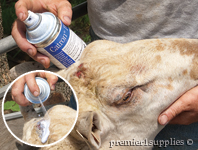
Catron® IV
The best product for treating sheep with fly-strike. Also a maggot, screwworm and ear-tick spray for livestock and horses. Kills and repels face flies.
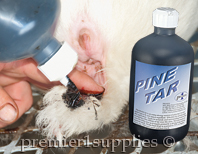
Pine Tar
Topical repellent for flies and insects. Those who pasture/range lamb apply it after docking, castrating and dehorning. Use on shearing cuts to prevent fly-strike as well.
GENERAL SHEEP CARE
Ten Tips for
Health & Happiness
Everyone has his or her own set of tips, but here are some good ones from veteran sheep farmers.
| 1. |
Establish regular feeding times. Feedings are usually given once in the morning and once in the evening.
|
| 2. |
Stick to the regular diet. Add the new feed and reduce the old feed over a period of several days to avoid making the sheep sick when you do need to change feed.
|
| 3. |
Provide plenty of fresh water. Water is an important part of your sheep’s good health, and they will drink more if it’s fresh.
|
| 4. |
Feed balanced rations. Base your sheep’s diet on feed analysis and nutritional requirements. If your sheep are getting their nutritional requirements through quality hay or pasture, don’t feed grain.
|
| 5. |
Practice good hoof care. Trim hooves one or twice a year.
|
| 6. |
Construct good fences. Everyone will be happier if the sheep remain where you would like them to be.
|
| 7. |
Compost that manure. Well-maintained pens will keep your sheep healthier, provide a good working environment, reduce flies, and help the garden grow.
|
| 8. |
Think like a sheep. Minimize stress. Herd and work around your sheep quietly with consistent gentle handling.
|
| 9. |
Provide shade. An open-sided shed, shade trees, or canopy roof can keep sheep cool in the summer.
|
| 10. |
Provide predator protection. Coyote-proof fencing, llamas, donkeys, and guard dogs can protect against predators.
|
Taken from Storey’s Barn Guide to Sheep, Storey Publishing. Edited by Deborah Burns, Sarah Guare, and Dale Perkins
|
 |
 |
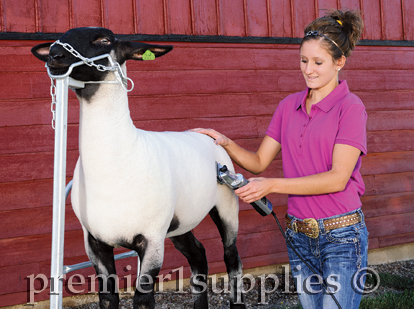
Weigh-in has come and gone but fair season is here! Gear up with the right equipment for clipping or blocking your sheep for the show.
Slick Shearing Show Sheep
Club lambs and some breeding sheep are slick shorn to accentuate their muscling for shows. This was originally done with a shear head until it was discovered in the late 1980s that:
| 1. |
Some clipper blades would cut through clean wool.
|
| 2. |
The result is better because clipper blades cut closer, leave a smoother finish, very rarely cut the animal, and require much less user experience. Now everyone uses a Premier 4000c (or similar) clipper.
|
Blade choices:
| • |
Fine: Leaves 0.06" of fiber. Best for beginners.
|
| • |
Surgical: 0.04". Less wool equals a better finish.
|
| • |
Super Surgical: 0.02". Only for experienced users. To reduce risk of cuts, nicks and blade-burns (on thin skin), stretch the skin ahead of the blades with your other hand.
|
Blocking Show Sheep
Most breeding sheep are “blocked” to prepare them for the show ring to emphasize shape and structure. Blocking is shearing wool using a Premier 4000s shearing machine (or similar) without the comb touching the animal’s skin.
Comb and cutter choices:
| • |
Phantom S is only for blocking show sheep. The “S” refers to the sharp tips on the comb’s teeth. Phantom “S” combs lack an upper bevel—which allows (if desired) the comb to be set so that the cutter tips are at the very tip of the comb’s teeth. That means it will instantly cut anything it touches (wool fibers, hide and/or human skin). Some users like this capability. If you don’t, set the comb a little further forward.
|
| • |
Phantom R and Spirit combs work well for shaping show animals but can also be used for shearing. Spirit combs have 13 teeth. Phantom combs have 20. The “R” indicates that the comb tips are rounded enough to allow them to be used for shearing against the skin.
|
| • |
Spitfire or Ceramic cutters work well for all 3 combs.
|
Need your blades, combs and cutters resharpened? Check out our factory-quality and rapid turnaround Resharpening Service.
|
VIP ARTICLE
Sheep Showing Essentials
Story and photos by Micky Burch
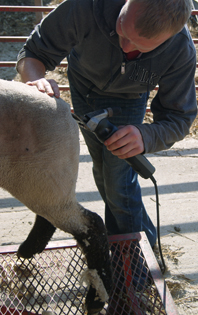
|
Kyle Wood, club lamb producer from Claypool, IN, roughs out a lamb with a 17-tooth comb.
|
As club lambs have become increasingly Hamp-influenced over the last few years, shearing and fitting sheep has evolved into an art form. Where it used to be popular to use Super Surgical blades to prepare a sheep for show, many fitters now prefer to use Fine or even Medium blades to accomplish a more natural look. But before the fun of fine-tune fitting comes into play, sheep need their baby wool knocked off. Following are the basics for roughing out, shearing for shows and fitting club lambs.
Roughing Out
“Roughing out” a sheep simply means shearing them roughly or not as precisely as for a show. Not only does roughing out help showmen really see what they have for a sheep out of the wool, it also increases a lamb’s growth rate. “Sheep perform better after they’ve been shorn,” Kyle Wood, club lamb producer from Claypool, Ind., says. “It also helps to better estimate their degree of finish and handling quality.”
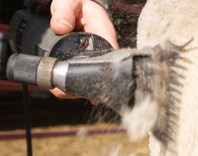
|
Oftentimes, clean sheep can be roughed out dry with a 13-, 17- or 20-tooth comb and a standard 4-point cutter on a set of sheep-head clippers.
|
Oftentimes, clean sheep can be roughed out dry with a 13-, 17- or 20-tooth comb (combs are the bottom part of a shearing set) and a standard 4-point cutter (cutters are the top part that moves back and forth) on a set of sheep-head clippers. Using a pattern that incorporates long strokes with the shear helps the comb/cutter last longer and the sheep to be shorn in a more efficient and timely manner. “Shearing with a pattern is better for the shearer and the sheep,” Wood explains. Anytime after weaning—approximately 60 days of age—it’s appropriate to start roughing out club lambs.
If the sheep is muddy or excessively dirty, it’s advised to clean it up prior to shearing. If proper cleanliness of the animal isn’t taken care of, accelerated comb/cutter wear and a reduction in the number of animals that can be shorn with a comb and cutter can be expected. Sheep can be prepared for shearing in several ways, including using a blow dryer to remove excess dirt and sand out of the fleece and shearing dry. Sheep can also be washed with soap and water and shorn wet. According to the Texas Agricultural Extension Service 4-H Show Lamb Guide by Frank Craddock and Ross Stultz: “A clean fleece is easier to shear and extends the life of combs and cutters. Any livestock soap or liquid dishwashing soap works well for washing lambs, but be careful to remove all the soap when rinsing the animal.”
Even when roughing them out, lambs should be shorn smooth. While shearing, run the shear parallel to the length of the body rather than vertically, the Show Lamb Guide says. Wool below the knees and hocks shouldn’t be shorn; this wool will be carded and blended during shearing and fitting at the show to improve the balance and eye appeal of the lamb.
Clipping for Shows
When it comes time to clip for show day, most judges recommend using Fine blades, which have 35 teeth, on the body and head of the sheep. “You don’t have to worry about clipper burn with Fines like you do Surgicals,” Wood says. “As long as the sheep has a smooth fleece pattern, Fine blades get them plenty close and help provide a nice touch.” However, if a sheep has a wavy wool pattern, it’s recommended to go ahead and use Surgical blades to get a closer cut resulting in a smoother clipping job. Clipping with fine blades should be done as close to the show or sale as possible. In fact, some producers recommend clipping the more difficult areas of the animal—like the head, brich and belly—at home and finish clipping on site. Regardless of where you clip, always wash the sheep with soap and water prior to clipping with Fine blades. Please reference following the rules of the show in respect to where you can and can’t clip on the grounds.
It’s also acceptable at this time to start shaping the leg wool, without taking too much off—a little extra length is good to have come show day. Leave the wool on the legs below the hocks and knees—it not only creates the impression of a heavy-boned lamb, it oftentimes preserves breed character.
After clipping for a show, it’s recommended to condition the lamb’s skin and cover them with a canvas blanket. Skin conditioners like Soft Soap or Refresh help to restore some of the oils to the skin that are lost during washing and shearing. Finally, cover your lamb with a canvas blanket. Compared to lamb tubes or socks that stretch across their skin, canvas allows the skin to breath and hydrate.
Fitting
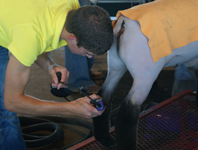
|
Nick Fitzsimmons, Vail, IA, clips in the hind legs of a wether with a small set of clippers.
|
It’s show day! The day you really get to show off your fitting skills. Since the sheep have been blanketed since clipping, it may not be necessary to wash them at the show unless they have a dirty spot on them. In that case, only wash the dirty spot, not the entire sheep.
Paying close attention to where the judge is at in the show, put your sheep on a fitting stand two to three classes prior to the class your sheep is in. To achieve an especially smooth touch on the body of the sheep, mix one gallon of water with Soft Soap by squirting the soap in the bucket for 5 seconds. Apply mixture to the body of the sheep with a soft bristled brush, then wipe the entire sheep off with a towel and allow the animal to dry.
While the sheep is drying, take a wool card and brush out all four legs of the animal. Using your sheep heads or a set of small clippers, shape the leg wool to look natural and uniform. “From the side, the rear legs should be uniform in diameter from the cap of the hock to the pastern,” Wood says. “From the rear view, the legs should be linear from the hock to the ground,” he continues, adding to clip the hock joint on the rear leg by blending it to look natural. Similar directions go for the front legs from the knee to the pastern.
From roughing out to priming just prior to the show, this simple guide outlines a few tips and tricks for your club lamb project.
|
FLY AND PEST CONTROL
Control of Sheep Pests
By Ralph E. Williams
Extension Entomologist, Purdue University
The sheep ked (Melophagus ovinus), often called the sheep “tick”, is a common pest of sheep. It looks somewhat like a tick but is actually a wingless fly, grayish-brown in color and 1/4 inch long. Its entire life cycle is spent on the host, except when accidentally dislodged; and it will readily crawl from one animal to another.
Sheep keds live 6-8 months, during which time the female produces about 15 young at the rate of approximately one a week. Breeding is continuous, although slower in winter; and there are several generations each year. Unlike most insects, the female gives birth to full-grown maggots, one at a time, which are attached to wool strands about the neck, inside the thighs and along the belly. Within a few hours after birth, the larval skin turns brown and forms a hard puparium. Fully developed keds emerge from the pupal cases in 2-5 weeks.
Read Complete Article »
|
|